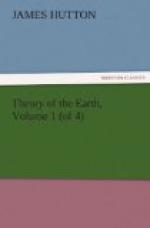Still, however, to pursue our visionary system, after a continent had been formed from the relicts of those animals, living, growing, and propagating, during an indefinite series of ages, plants at last are formed; and, what is no less wonderful, those animals which had formed the earth then disappear; but, in compensation, we are to suppose, I presume, that terrestrial animals began. Let us now reason from those facts, without either constraining nature, which we know, or forming visionary systems, with regard to things which are unknown. It would appear, that at one period of time, or in one place, the matter of the globe may be deposited, in strata, without containing any organised bodies; at another time, or in another place, much animal matter may be deposited in strata, without any vegetable substance there appearing; but at another period, or at another time, strata may be formed with much vegetable matter, while there is hardly to be observed any animal body. What then are we to conclude upon the whole? That nature, forming strata, is subject to vicissitudes; and that it is not always the same regular operation with respect to the materials, although always forming strata upon the same principles. Consequently, upon the same spot in the sea, different materials may be accumulated at different periods of time, and, conversely, the same or similar materials may be collected in different places at the same time. Nothing more follows strictly from the facts on which we now are reasoning; and this is a conclusion which will be verified by every appearance, so far as I know.
Of this I am certain, that in a very little space of this country, in many places, such a course of things is to be perceived. Nothing so common as to find alternated, over and over again, beds of sand-stone without animal bodies, beds of coal and schistus abounding with vegetable bodies, beds of lime-stone formed of shells and corals, and beds or particular strata of iron-stone containing sometimes vegetable sometimes animal bodies, or both. Here, indeed, the strata are most commonly inclined; it is seldom they are horizontal; consequently, as across the whole country, all the strata come up to the day, and may be seen in the beds of our rivers, we have an opportunity of observing that great variety which is in nature, and which we are not able to explain. This only is certain, from what we see, that there is nothing formed in one epoch of nature, but what has been repeated in another, however dissimilar may be the operations which had intervened between those several epochs.




